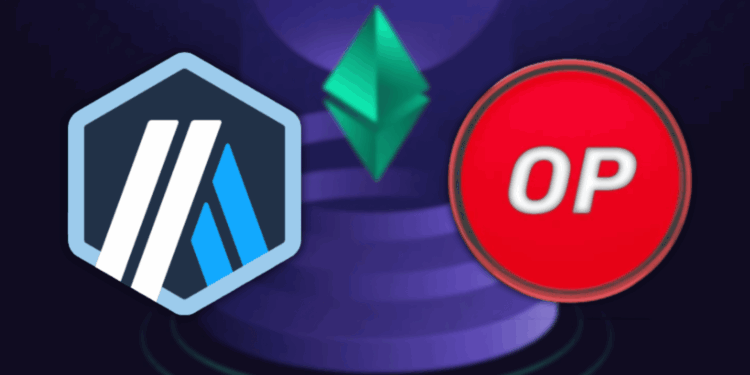- Arbitrum leads in TVL, user activity, and liquidity, while Optimism excels in transaction volume and developer adoption through its OP Stack and Superchain model.
- Both projects are backed by top-tier investors, but differ in vision—Arbitrum pushes for sovereign scalability, while Optimism focuses on unified, modular networks.
- Tech stack divergence is key: Arbitrum’s Orbit enables custom chains and high throughput; Optimism’s Superchain ties ecosystems together for seamless interoperability.
The Ethereum scaling wars are heating up—and two Layer-2 giants, Arbitrum and Optimism, are leading the charge. These aren’t experimental chains. They’re multi-billion-dollar ecosystems that have become the backbone of modern DeFi and a breeding ground for next-gen Web3 infrastructure. But they’ve taken very different paths to get there. One is about modular unity; the other is about sovereign flexibility.
So which chain is more likely to dominate the future of Ethereum’s scalability? Let’s dive in.
Ecosystem Growth & User Activity: Arbitrum Still Holds the Crown
Right now, Arbitrum is the clear front-runner in adoption. As of late June 2025, it commands over $2.9 billion in total value locked (TVL), handles more than 1.1 million in daily DEX volume, and sees over 330,000 daily active addresses. It’s where a lot of serious DeFi builders are already set up, and the liquidity speaks for itself.
Optimism, however, is steadily gaining ground. It holds around $440 million in TVL and supports more than 1.2 million daily transactions across its ecosystem. Despite having fewer active wallets (about 68,000 daily), its new “OP Chains” launched under the Superchain umbrella are drawing both developers and users in.
What’s worth noting is retention: roughly 35–45% of new users stick around on both platforms after 30–60 days. Arbitrum benefits from open interest and organic growth, especially with its Orbit expansion and sequencer profits. Optimism wins with its deep incentive system—community grants, on-chain quests, and OP token-based rewards.
Bottom line: Arbitrum is winning in size and liquidity. Optimism is thriving through incentives and cross-chain expansion.
Funding and Strategic Backers: Big Players on Both Sides
The battle for L2 dominance isn’t just happening on-chain—it’s also backed by deep-pocketed investors. Arbitrum boasts support from names like Lightspeed, Pantera, and Paradigm. It’s also built deep relationships with DeFi giants like Uniswap, GMX, and Gains Network. Its financial support has enabled ecosystem expansion, new tooling, and Layer 3 network development.
Optimism isn’t falling behind. Backers include a16z, the Ethereum Foundation, and Paradigm, along with recent capital raises to support the Superchain model. What sets Optimism apart is its commitment to public goods. The OP Stack includes governance for OP Chains, meaning token holders have real influence—and developers are rewarded for building open, composable infrastructure.
Think of Arbitrum as focusing on centralized execution with decentralized options. Optimism is betting on modularity and collective infrastructure. Both have war chests and momentum—but they’re fueling very different visions of Ethereum’s future.
Future Tech: OP Stack vs Orbit
This is where the real divergence happens.
Optimism’s OP Stack is powering over 40 chains already—Base (Coinbase), Blast, and more. The Superchain model ties these chains together under shared governance, liquidity, and tooling. It’s designed to scale Ethereum horizontally and reduce fragmentation. Recent upgrades like OP Succinct Lite cut withdrawal times with ZK fraud proofs—an important UX win.
Arbitrum, meanwhile, is going full-speed into customizable scaling. With Orbit chains, developers can build their own L2s and L3s using Arbitrum Nitro. It’s flexible, fast, and now supports custom VMs like Stylus for Rust and C++ devs. Upcoming tech includes BoLD+ and recursive proofs—bringing fast finality and enabling 100x throughput across the Orbit ecosystem.
The comparison? Optimism is building a unified Ethereum-aligned world. Arbitrum is building a multiverse where each chain can run on its own terms. Both approaches could win—but they solve different scaling needs.
Choose Your Scaling Weapon
At the end of the day, this isn’t a winner-takes-all scenario. Arbitrum and Optimism are both pushing Ethereum into its next era.
If you want liquidity, institutional DeFi access, and battle-tested apps, Arbitrum is your go-to. If you want a future of interoperable chains, open-source governance, and developer-first tooling, Optimism may be your chain.
The smarter strategy might not be picking one over the other—but knowing when and how to use each. Ethereum scaling is no longer a question of “if”—but “how fast” and “through which rails.”














